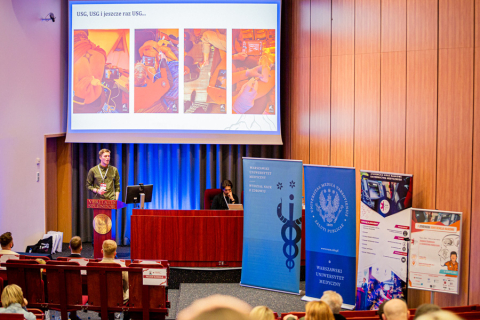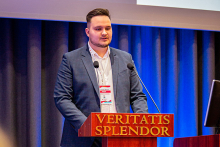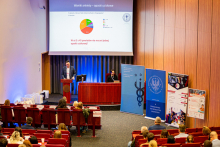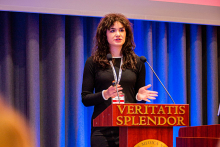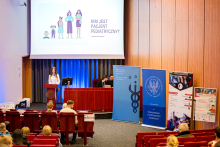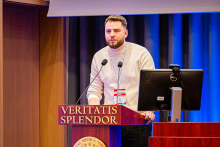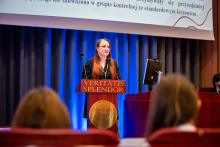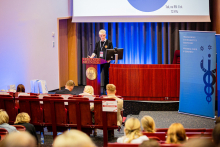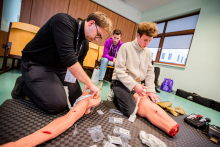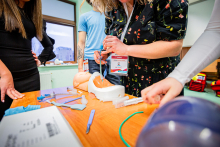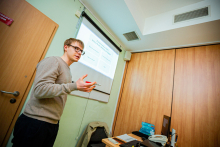The conference was hosted by the Emergency Medical Services Student Scientific Club at the Department of Emergency Medical Services, Faculty of Health Sciences, Medical University of Warsaw (MUW). This year, interest in the event was very high, with more than 400 participants registered from across Poland.
The participants were welcomed and the conference was officially opened by Prof. Robert Gałązkowski, Chairman of the Discipline Council of Health Sciences and Head of the Department of Emergency Medical Services at the Faculty of Health Sciences, MUW. The event was also attended by the Vice Deans of the Faculty of Health Sciences: Dr Łukasz Czyżewski, Dr Justyna Teliga-Czajkowska, and Dr Patryk Rzońca, who delivered the inaugural lecture titled “The Future of Emergency Medical Services – Challenges, Innovations and the Role of the Paramedic in a dynamically changing world”.
The conference was chaired by Ignacy Sakiewicz and Izabella Nasiłowska, representatives of the Student Government at the Faculty of Health Sciences.
More than just emergency medical services
The programme of the event was very diverse and included four thematic sessions: “Cooperation, Organisation and Challenges in Emergency Medical Services”, “Emergency Diagnostics and Interventions”, “Specificity of Paediatric Patients and Mountain Emergency Medicine”, as well as “Modern Technologies, Psychology and the Future of Emergency Medical Services”.
As many as 15 lectures were delivered, such as medical triage of paediatric patients in hospital emergency departments, concerns around making accurate decisions; out-of-hospital deliveries in paramedic practice; the use of ultrasound in diagnosing shock in the paramedic team setting; and prospects for further studies after obtaining a bachelor’s degree in emergency medical services. The speakers included paramedic students from the Faculty of Health Sciences at MUW, as well as medical students from other universities in Poland. The event was both insightful and inspiring.
According to attendees, the most engaging lecture was “A Turning Point in a Patient’s Life: Emergency Conditions in Endocrinology”, delivered by Dariusz Butkiewicz, a third-year paramedic student at MUW. He received the Audience Award.
Practice makes perfect
To complement the lectures, four hands-on workshops were held:
- “Airways under control”, conducted by members of the Ankona B Student Scientific Club at the 2nd Department of Anaesthesiology and Intensive Care. Participants practised both basic and advanced airway management techniques, essential for quick and effective action in life-threatening situations when the patient is not breathing, suffocating and time is running out.
- “Controlling Haemorrhage in Transitional Zones”, led by Jakub Zachaj from the Department of Emergency Medical Services of the Faculty of Health Sciences, MUW. The session enabled participants to practise managing bleeding in transitional areas, e.g. the groin, neck or armpits, where conventional techniques may be insufficient.
- “Demystifying the ECG”, conducted by Jakub Zabłocki, a fifth-year medical student and member of the Student Scientific Club at the 1st Chair and Department of Cardiology and the Student Scientific Club of Paediatric Cardiology. During the workshop, the participants were guided step by step through ECG interpretation, identifying both common and less frequent abnormalities.
- The 21st-Century Stethoscope: The Ultrasound Transducer”. What use is the transducer in paramedic teams? How to “auscultate the patient” without a stethoscope? How to diagnose internal bleeding before getting to the hospital? What is the eFAST protocol? These were discussed and demonstrated by the workshop leaders: Zofia Majcher and Dariusz Żegliński, third-year paramedic students and members of the Student Scientific Club of Pre-Hospital Medicine at the Department of Emergency Medical Services.
The event was held under the patronage of the Rector of the Medical University of Warsaw, the Dean of the Faculty of Health Sciences, and the MUW Student Government.
